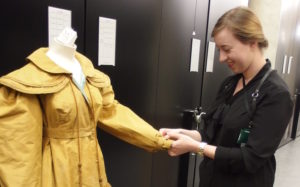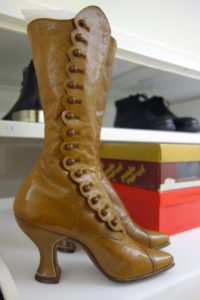
M.Litt History of Art: Dress & Textile Histories student Virginia Knight recently completed a work placement at the V&A Museum in Kensington as a part of her degree programme. We spoke to her about her experience.

In April I travelled to London with three fellow students to complete a work placement at the Victoria & Albert Museum. The V&A is the world’s leading museum of art and design, and they are known for their incredible fashion exhibitions. We were based both in the Furniture, Textiles, and Fashion department and at the Clothworkers’ Centre for the Study and Conservation of Textiles and Fashion for the four weeks of our placement. As a student on the M.Litt Dress & Textile Histories program, the chance to work at such an iconic museum in my field was truly a once-in-a-lifetime experience.
 We worked on a variety of different projects during our month-long placement. The first project was an audit of the V&A’s shoe collection, as well as an audit of hanging menswear (pieces that are in hanging storage, as opposed to drawer storage). We printed out all the information from the V&A’s collections management system and checked this information against the physical objects – so, are the shoes where they’re supposed to be? Do they have the right label? Any errors are corrected throughout the course of the audit. I worked on the shoe audit project, and we audited 16 cabinets’ worth (over 1,000 shoes!) in total. We worked chronologically through the shoe collection, and by the time we finished, we had seen everything from women’s Victorian boots to men’s 1970s flatforms.
We worked on a variety of different projects during our month-long placement. The first project was an audit of the V&A’s shoe collection, as well as an audit of hanging menswear (pieces that are in hanging storage, as opposed to drawer storage). We printed out all the information from the V&A’s collections management system and checked this information against the physical objects – so, are the shoes where they’re supposed to be? Do they have the right label? Any errors are corrected throughout the course of the audit. I worked on the shoe audit project, and we audited 16 cabinets’ worth (over 1,000 shoes!) in total. We worked chronologically through the shoe collection, and by the time we finished, we had seen everything from women’s Victorian boots to men’s 1970s flatforms.
Photography projects are an important part of museum work, as museums aim to make more of their collections accessible online. We worked on several photography projects in April, including 19th century shawl photography, fan photography, and 1830s dress photography. My favourite of the three was the 1830s dress photography, as the dresses were beautiful in their own right and proved an interesting challenge to mount. We took a dress form and added a net petticoat under the bust, to help create the correct silhouette for the period. A satin petticoat was added on top, as a smooth surface helps the dress slip on the dress form. Once the dress was on the form, we pinned and adjusted the dress as necessary. We were taking “object record” shots, so it was more important to get a general sense of what the dress looks like than to mount the dress perfectly on the mannequin.
In addition to our larger projects, we helped with research for upcoming exhibitions, examined textile pieces in individual research appointments, sewed labels into clothing, repacked textiles, saw exhibitions at the V&A, and got to do the most glamorous museum job of all – setting bug traps! Maybe not glamorous, but certainly a necessary part of museum work. We attended the “Creating the Europe 1600-1815 Galleries” conference at the V&A’s South Kensington location, which was a great opportunity to learn about all the work that went into designing the new European gallery (in which there are some very beautiful dress and textile pieces on display).
The month went by so quickly, and by the end of our placement we had gained so much experience in different areas of museum work. The V&A has an incredible collection of dress and textiles, and to work hands-on with these objects was a dream come true – a huge thank you to Dr. Sally Tuckett for coordinating the work placement at University of Glasgow, and to Jenny Lister and Suzanne Smith at the Victoria & Albert Museum for all their hard work in making this placement possible.

